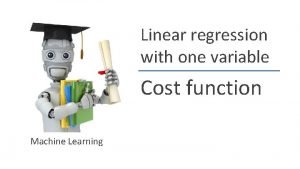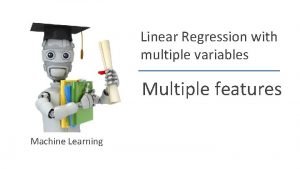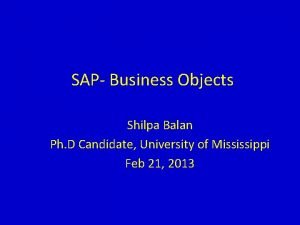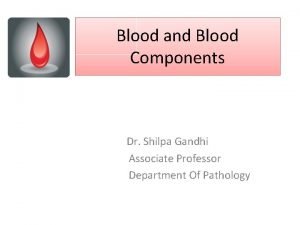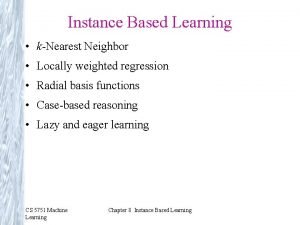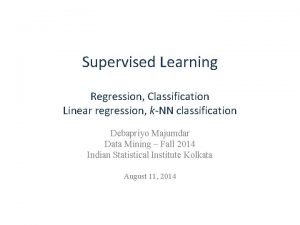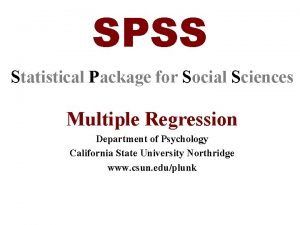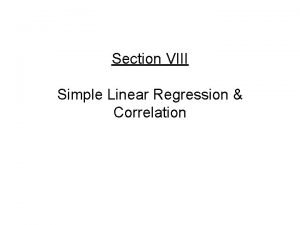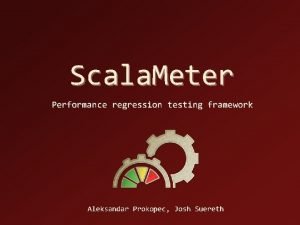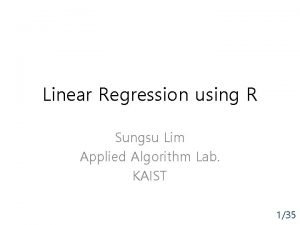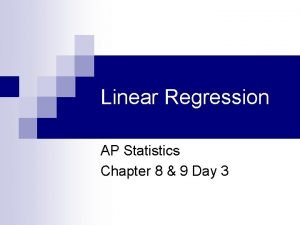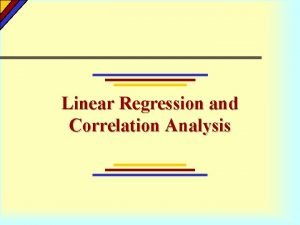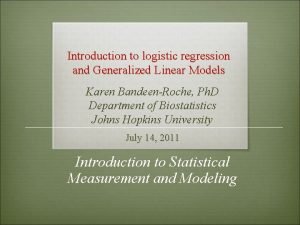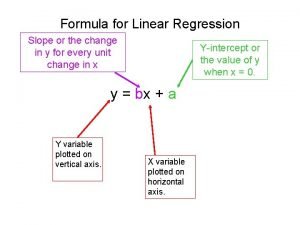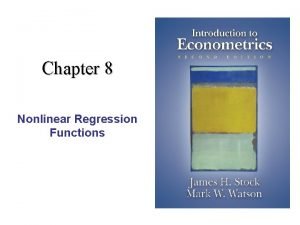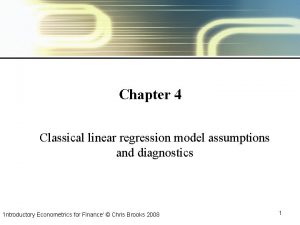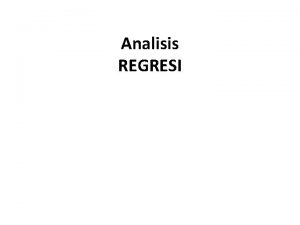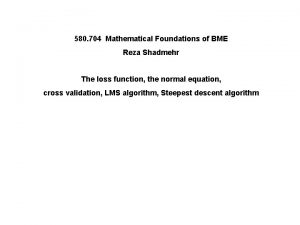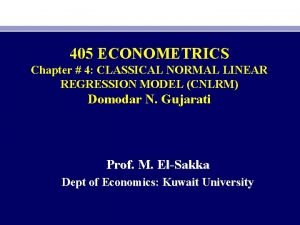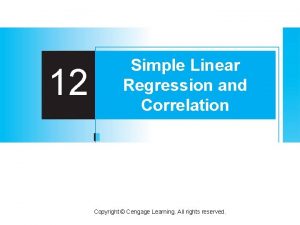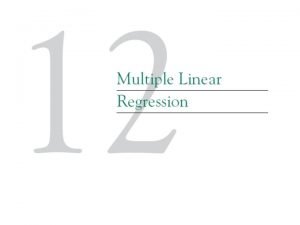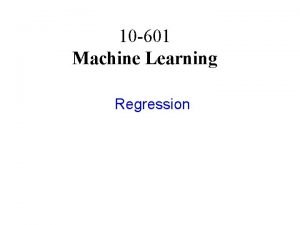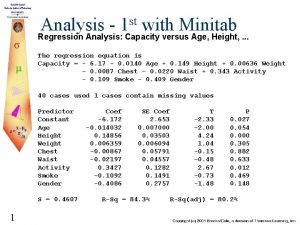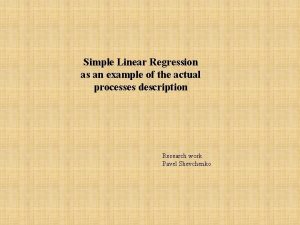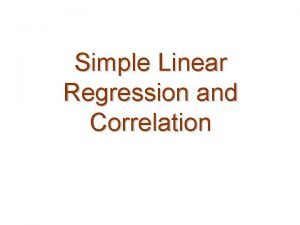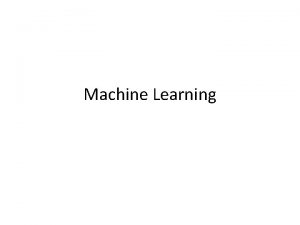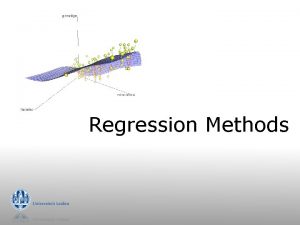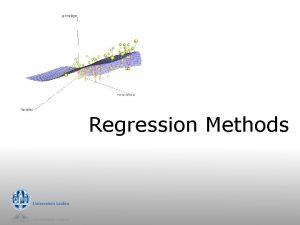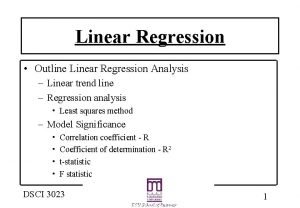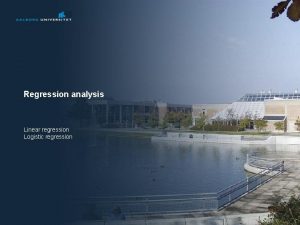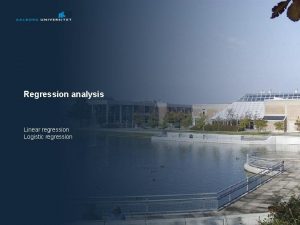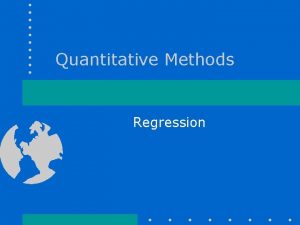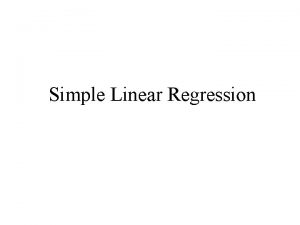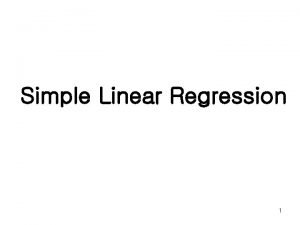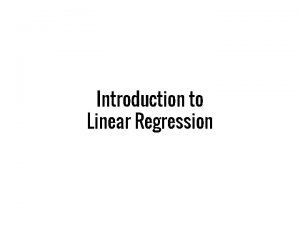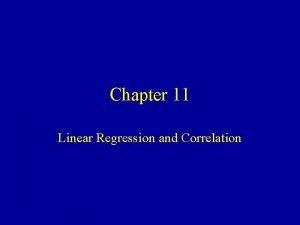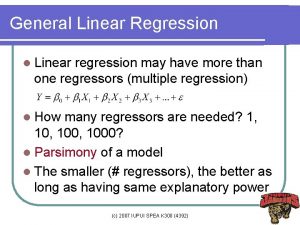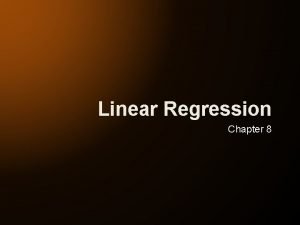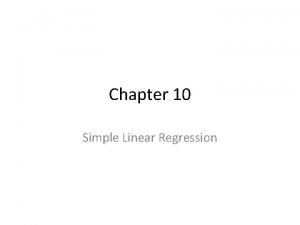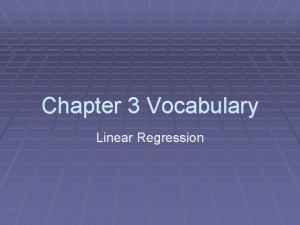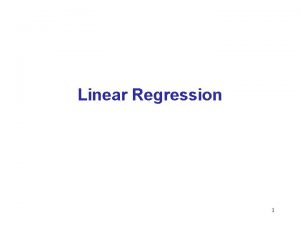Linear Regression Shilpa Sonawani Machine learning Machine learning

















![σx = sqrt [ Σ ( xi - x )2 / N ] σx σx = sqrt [ Σ ( xi - x )2 / N ] σx](https://slidetodoc.com/presentation_image_h2/5c6156530715a7b8150868bd4f61d49e/image-18.jpg)














- Slides: 32

Linear Regression Shilpa Sonawani

Machine learning • Machine learning is a discipline that deals with programming the systems so as to make them automatically learn and improve with experience. • Here, learning implies recognizing and understanding the input data and taking informed decisions based on the supplied data. • It is very difficult to consider all the decisions based on all possible inputs. To solve this problem, algorithms are developed that build knowledge from a specific data and past experience by applying the principles of statistical science, probability, logic, mathematical optimization, reinforcement learning, and control theory

Regression • Regression is a statistical measure used in finance, investments and other disciplines that attempts to determine the strength of the relationship between one dependent variable (usually denoted by Y) and a series of other changing variables (known as independent variables). • TYPES: • Simple Linear Regression • Multi Linear Regression • Polynomial Linear Regression

Simple Linear Regression ANALYZING DATASET IV DV

Simple Linear Regression EQUATION PLOTTING SALARY (₹) y = b 0 + b 1 * x 1 SALARY = b 0 + b 1 * EXPERIENCE +10 K +1 Yr HOW much Salary will increase? +1 Yr EXPERIENCE

Simple Linear Regression Constant Coefficient y = b 0 + b 1 * x 1 Dependent variable (DV) Independent variable (IV)

Simple Linear Regression ORDINARY LEAST SQUARES • How SLR finds Best Fitting Line from our Data SALARY (₹) yi y^i Mr. ABC Modeled Observation SUM ( y - y^)2 -> min EXPERIENCE

Least Square Method • Finds the line of best fit for a dataset, providing a visual demonstration of the relationship between the data points. • The differences between the actual and estimated function values on the training examples are called residuals • The least-squares method, consists in finding ˆ f such that is minimised


Ex: Least Square method using Univariate Regression x y x – x mean y - y mean (x – x mean)2 1 2 3 4 5 2 4 5 -2 -1 0 1 2 -2 0 1 4 1 0 1 4 (x – x mean). (y – y mean) 4 0 0 0 2


Problem Statement • Last year, five randomly selected students took a math aptitude test before they began their statistics course. The Statistics Department has three questions. • What linear regression equation best predicts statistics performance, based on math aptitude scores? • If a student made an 80 on the aptitude test, what grade would we expect her to make in statistics? • How well does the regression equation fit the data?

Student x y 1 95 85 2 85 95 3 80 70 4 70 65 5 60 70 Sum 390 385 mean 78 77 x – x mean y - y mean (x – x mean)2 (x – x mean). (y – y mean)

Libraries and Packages in Python • sklearn : – the algorithms used for data analysis and data mining tasks. • Num. Py : – It is a numeric python module which provides fast maths functions for calculations. – It is used to read data in numpy arrays and for manipulation purpose. • Pandas : – Used to read and write different files. – Data manipulation can be done easily with dataframes. • matplotlib − is 2 D plotting library for creating graphs and plots • seaborn − a data visualization library based on matplotlib

How to Find the Regression Equation • The regression equation is a linear equation of the form: ŷ = b 0 + b 1 x • First, we solve for the regression coefficient (b 1): • b 1 = Σ [ (xi - x)(yi - y) ] / Σ [ (xi - x)2] • b 1 = 470/730 • b 1 = 0. 644 • Once we know the value of the regression coefficient (b 1), we can solve for the regression slope (b 0): • b 0 = y - b 1 * x • b 0 = 77 - (0. 644)(78) • b 0 = 26. 768 • Therefore, the regression equation is: ŷ = 26. 768 + 0. 644 x.

How to Use the Regression Equation • In our example, the independent variable is the student's score on the aptitude test. • The dependent variable is the student's statistics grade. • If a student made an 80 on the aptitude test, the estimated statistics grade (ŷ) would be: • ŷ = b 0 + b 1 x • ŷ = 26. 768 + 0. 644 x = 26. 768 + 0. 644 * 80 • ŷ = 26. 768 + 51. 52 = 78. 288

How to Find the Coefficient of Determination • Whenever you use a regression equation, you should ask how well the equation fits the data. • One way to assess fit is to check the coefficient of determination, which can be computed from the following formula. • R 2 = { ( 1 / N ) * Σ [ (xi - x) * (yi - y) ] / (σx * σy ) }2 – – – – where N is the number of observations used to fit the model, Σ is the summation symbol, xi is the x value for observation i, x is the mean x value, yi is the y value for observation i, y is the mean y value, σx is the standard deviation of x, and σy is the standard deviation of y.
![σx sqrt Σ xi x 2 N σx σx = sqrt [ Σ ( xi - x )2 / N ] σx](https://slidetodoc.com/presentation_image_h2/5c6156530715a7b8150868bd4f61d49e/image-18.jpg)
σx = sqrt [ Σ ( xi - x )2 / N ] σx = sqrt( 730/5 ) = sqrt(146) = 12. 083 σy = sqrt [ Σ ( yi - y )2 / N ] σy = sqrt( 630/5 ) = sqrt(126) = 11. 225 And finally, we compute the coefficient of determination (R 2): R 2 = { ( 1 / N ) * Σ [ (xi - x) * (yi - y) ] / (σx * σy ) }2 R 2 = [ ( 1/5 ) * 470 / ( 12. 083 * 11. 225 ) ]2 R 2 = ( 94 / 135. 632 )2 = ( 0. 693 )2 = 0. 48 A coefficient of determination equal to 0. 48 indicates that about 48% of the variation in statistics grades (the dependent variable) can be explained by the relationship to math aptitude scores (the independent variable). • This would be considered a good fit to the data, in the sense that it would substantially improve an educator's ability to predict student performance in statistics class. • • •

Linear regression with scikit-learn and higher dimensionality • • • from sklearn. datasets import load_boston >>> boston = load_boston() >>> boston. data. shape (506 L, 13 L) >>> boston. target. shape (506 L,

• pandas. Data. Frame(boston. data, columns=boston. feature_names)

• from sklearn. linear_model import Linear. Regression • from sklearn. model_selection import train_test_split • >>> X_train, X_test, Y_train, Y_test = train_test_split(boston. data, • boston. target, test_size=0. 1) • >>> lr = Linear. Regression(normalize=True) • >>> lr. fit(X_train, Y_train) • Linear. Regression(copy_X=True, fit_intercept=True, n_jobs=1, normalize=True)

k-fold cross-validation • The whole dataset is split into k folds using always k-1 folds for training and the remaining one to validate the model. • K iterations will be performed, using always a different validation fold • The final score can be determined as average of all values and all samples are selected for training k-1 times.

Accuracy of a regression • To check the accuracy of a regression, scikit-learn provides the internal method • score(X, y) which evaluates the model on test data: • >>> lr. score(X_test, Y_test) • 0. 77371996006718879 • Linear. Regression works with ordinary least squares, we preferred the negative mean squared error, which is a cumulative measure that must be evaluated according to the actual values (it's not relative).

Using cross_val_score() • from sklearn. model_selection import cross_val_score • >>> scores = cross_val_score(lr, boston. data, boston. target, cv=7, • scoring='neg_mean_squared_error') • array([ -11. 32601065, -10. 96365388, -32. 12770594, 33. 62294354, • -10. 55957139, -146. 42926647, -12. 98538412]) • >>> scores. mean() • -36. 859219426420601 • >>> scores. std() • 45. 704973900600457

Ridge • Ridge regression imposes an additional shrinkage penalty to the ordinary least squares loss function to limit its squared L 2 norm:

coefficient of determination or R 2. • It measures the amount of variance on the prediction which is explained by the dataset. • In other words, it is the difference between the sample and the prediction. So the R 2 is defined as follows: • For our purposes, R 2 values close to 1 mean an almost perfect regression, while values close to 0 (or negative) imply a bad model. • Using this metric is quite easy with cross-validation: • >>> cross_val_score(lr, X, Y, cv=10, scoring='r 2') • 0. 75

Regressor analytic expression • If we want to have an analytical expression of our model (a hyperplane), Linear. Regression offers two instance variables, intercept_ and coef_: • >>> print('y = ' + str(lr. intercept_) + ' ') • >>> for i, c in enumerate(lr. coef_): • print(str(c) + ' * x' + str(i))

Ridge • Ridge regression imposes an additional shrinkage penalty to the ordinary least squares loss function to limit its squared L 2 norm: • X is a matrix containing all samples as columns • w represents the weight vector. • The additional term (through the coefficient alpha—if large it implies a stronger regularization and smaller values) forces the loss function to disallow an infinite growth of w, which can be caused by multicollinearity or ill-conditioning

• • • from sklearn. datasets import load_diabetes from sklearn. linear_model import Linear. Regression, Ridge >>> diabetes = load_diabetes() >>> lr = Linear. Regression(normalize=True) >>> rg = Ridge(0. 001, normalize=True) >>> lr_scores = cross_val_score(lr, diabetes. data, diabetes. target, cv=10) >>> lr_scores. mean() 0. 46196236195833718 >>> rg_scores = cross_val_score(rg, diabetes. data, diabetes. target, cv=10) >>> rg_scores. mean() 0. 46227174692391299

• from sklearn. linear_model import Ridge. CV • >>> rg = Ridge. CV(alphas=(1. 0, 0. 1, 0. 005, 0. 0025, 0. 001, 0. 00025), • normalize=True) • >>> rg. fit(diabetes. data, diabetes. target) • >>> rg. alpha_ • 0. 005000000001

• A Lasso regressor imposes a penalty on the L 1 norm of w to determine a potentially higher number of null coefficients: • from sklearn. linear_model import Lasso • >>> ls = Lasso(alpha=0. 001, normalize=True) • >>> ls_scores = cross_val_score(ls, diabetes. data, diabetes. target, cv=10) • >>> ls_scores. mean() • 0. 46215747851504058

 Simple multiple linear regression
Simple multiple linear regression Survival analysis vs logistic regression
Survival analysis vs logistic regression Logistic regression vs linear regression
Logistic regression vs linear regression Multiple linear regression
Multiple linear regression Cost function andrew ng
Cost function andrew ng Gradient descent multiple variables
Gradient descent multiple variables Linear regression with multiple variables machine learning
Linear regression with multiple variables machine learning Shilpa balan
Shilpa balan Dr shilpa gandhi
Dr shilpa gandhi Locally weighted regression in machine learning
Locally weighted regression in machine learning Knn linear regression
Knn linear regression Hierarchical linear regression spss
Hierarchical linear regression spss Linear regression riddle b
Linear regression riddle b Scalameter
Scalameter Multiple linear regression
Multiple linear regression Arti regresi linier
Arti regresi linier Multiple regression assumptions spss
Multiple regression assumptions spss Sum of squares
Sum of squares Ap statistics linear regression
Ap statistics linear regression Linear regression example
Linear regression example Log linear regression model
Log linear regression model F statistic formula anova
F statistic formula anova Log linear regression model
Log linear regression model Assumptions of classical linear regression model
Assumptions of classical linear regression model History of regression analysis
History of regression analysis Linear regression loss function
Linear regression loss function Classical normal linear regression model
Classical normal linear regression model Simple linear regression hypothesis
Simple linear regression hypothesis Multiple linear regression variance
Multiple linear regression variance Machine learning 10-601
Machine learning 10-601 Minitab regression analysis
Minitab regression analysis Multiple linear regression analysis formula
Multiple linear regression analysis formula Linear regression riddle a answer key
Linear regression riddle a answer key




